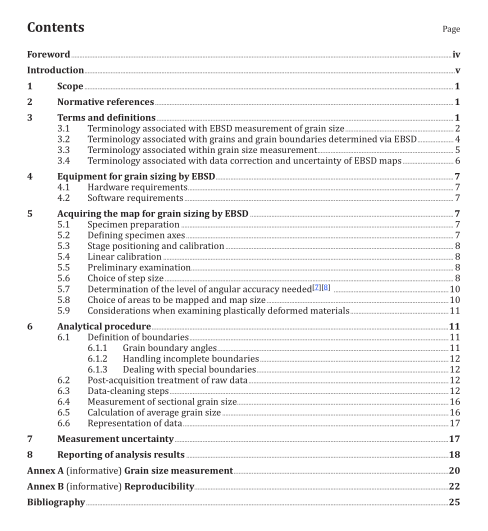ISO 13067:2020 pdf download.Microbeam analysis — Electron backscatter diffraction — Measurement of average grain size
5 Acquiring the map for grain sizing by EBSD
5.1 Specimen preparation
In order to achieve a high degree of indexing of individual pixels (a high indexing hit rate), it is necessary to produce a surface finish which produces EBSD patterns of sufficient quality to be indexed reliably. The criteria used for indexing reliability shall be defined and reported by the user. The surface preparation method adopted will be dependent on the material and also on its condition e.g. metallurgical heat treatment. The reader should refer to standard texts on polishing and etching and ISO 24173:2009, Annex B. Over-etching of grain boundaries should be avoided since it leads to increased numbers of non- and mis-indexed points and to low index reliability at the grain boundaries. If necessary, the specimen may be coated with a thin conductive coating (such as carbon) to prevent charging and electron beam drift and thus avoid distortion of the image.
5.2 Defining specimen axes
If the specimen is known to be strongly textured, e.g. from thermomechanical processing, the axes of the specimen shall be identified prior to preparation for EBSD such that EBSD measurements can be related to these axes. These axes are usually related to the rolling direction (for metals), to a growth direction (e.g., in thin films) or to a principal applied stress.
5.3 Stage positioning and calibration
The procedures set out in ISO 24173 shall be followed. The specimen shall be fixed to the scanning electron microscope (SEM) stage in the desired orientation with the specimen axes relative to the stage axes and imaged at a working distance at which the SEM and EBSD image magnifications have been calibrated and at which the EBSD system itself has been calibrated to index diffraction patterns. The purpose of this calibration is to check that there is no influence of distortion on the recorded patterns and to ensure that the tilt angle relative to the specimen is correct. Reference [4] discusses distortion round the edges.
The specimen tilt has a significant effect on the image magnification in the direction on the specimen surface normal to the tilt axis. Great care shall be taken to measure the tilt angle of the specimen surface accurately.
NOTE A 1° change in tilt angle at a tilt angle at 70° will cause a change of ∼5 % in the size of the step used in the direction on the specimen surface normal to the tilt axis when collecting data for the map.
5.4 Linear calibration Follow the recommendations of ISO 16700.
5.5 Preliminary examination An initial examination of the specimen shall be made to identify an initial set of operating parameters needed to map the orientation of the specimen with an acceptable level of accuracy and within an acceptable period of time over an area sufficient to give data on a statistically significant number of grains.
The reader is referred to ISO 24173 for information needed to measure the orientation.
5.6 Choice of step size
5.6.1 If the grain size and shape are not known already, an approximate grain size and shape estimation shall be performed by a quick imaging technique. An optical microscope might work on a region with only slight polishing relief or on an etched region adjacent to that to be examined by EBSD. Forescatter [5] or electron-channelling contrast imaging using diodes mounted on the EBSD detector, or imaging with the specimen current, can also produce images relatively quickly. As an alternative to mapping, some EBSD software offers a line intercept method as a mapping mode. This can be used to quickly give an approximate grain size measurement.
5.6.2 The step size should be chosen in relation to the average grain size, unless information on a particular minimum size is required. In either case, it shall be recognized that a judgement is being made on the minimum number of pixels that are used to define a grain either by a lineal or areal method. See also 6.3 and Figures 1 d), e) and f) for the effects of step size choice.ISO 13067 pdf download.ISO 13067 pdf download
